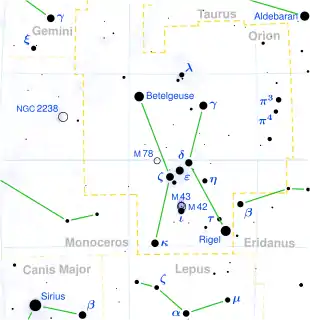Upsilon Orionis
Upsilon Orionis (υ Ori, υ Orionis) is a star in the constellation Orion. It has the traditional name Thabit /ˈθeɪbɪt/[6] or Tabit (ﺛﺎﺑﺖ, Arabic for "the endurer"), a name shared with pi3 Orionis. It is a blue-white main sequence star of apparent magnitude 4.62 located over 3000 light-years distant from the Solar System. It is a suspected Beta Cephei variable.
 | |
| Observation data Epoch J2000.0 Equinox J2000.0 | |
|---|---|
| Constellation | Orion |
| Right ascension | 05h 31m 55.86019s[1] |
| Declination | –07° 18′ 05.5371″[1] |
| Apparent magnitude (V) | +4.618 ± 0.013[2] |
| Characteristics | |
| Spectral type | O9.7 V[3] |
| U−B color index | –1.068 ± 0.008[2] |
| B−V color index | –0.264 ± 0.007[2] |
| Variable type | suspected β Cep[4] |
| Astrometry | |
| Radial velocity (Rv) | +17.4[5] km/s |
| Proper motion (μ) | RA: –0.10[1] mas/yr Dec.: –4.87[1] mas/yr |
| Parallax (π) | 1.14 ± 0.25[1] mas |
| Distance | approx. 2,900 ly (approx. 900 pc) |
| Details | |
| Surface gravity (log g) | 4.30 ± 0.05[2] cgs |
| Temperature | 33,400 ± 200[2] K |
| Rotational velocity (v sin i) | 20 ± 2[2] km/s |
| Other designations | |
| Database references | |
| SIMBAD | data |
Name
Located south of Iota Orionis,[7] Upsilon Orionis is one of two stars (the other is 29 Orionis) marking the top of Orion's right boot in Johann Bayer's Uranometria (1603).[8] It was given the number 36 by John Flamsteed, while its proper name appears to be derived from the Arabic Al Thabit "the endurer".[7] In his Star-Names and Their Meanings (1899), American amateur naturalist Richard Hinckley Allen noted that the name appeared on the star atlas Geography of the Heavens, composed by Elijah Hinsdale Burritt, but its ultimate origin was unknown.[9]
Properties
Since 1943, this star has been consistently defined as a B0 main sequence star used as a reference for classifying the spectra of other stars on the MK scale,[10] although in other studies it has been classified as O9V[11] and O9.5V.[12] The Galactic O-Star Spectroscopic Survey has defined it as the standard star for the O9.7 V spectral type.[3]
In a 1981 paper, υ Orionis was observed to have nonradial pulsations over a period of around 12 hours, and has been classified as a Slowly pulsating B star.[12] Subsequent review of Hipparcos catalog data indicated it was most likely a Beta Cephei variable, and is hence considered a candidate for that class.[13] These are blue-white main sequence stars of around 10 to 20 times the mass of the Sun that pulsate with periods of 0.1 to 0.3 days; their changes in magnitude are much more pronounced in the ultraviolet than in the visual spectrum.[14] It is classified as a Beta Cephei variable by the American Association of Variable Star Observers, and has an apparent magnitude of +4.62.[4]
υ Orionis's parallax has been measured at 1.14 ±0.25, yielding a distance of approximately 3158 light years from Earth.[1] A 1979 review of photometry of O and B stars found it to be around 1666 light-years distant, with a radius 7.2 times and luminosity 60,000 times that of the Sun, and surface temperature of 34347 K.[11] and a mass 20 times that of the Sun. It is one of the most massive stars of the Orion OB1c Association (in Orion's Sword).[12]
References
- van Leeuwen, F. (2007). "Validation of the new Hipparcos reduction". Astronomy and Astrophysics. 474 (2): 653–664. arXiv:0708.1752. Bibcode:2007A&A...474..653V. doi:10.1051/0004-6361:20078357. S2CID 18759600. Vizier catalog entry
- Nieva, M.-F. (February 2013), "Temperature, gravity, and bolometric correction scales for non-supergiant OB stars", Astronomy & Astrophysics, 550: A26, arXiv:1212.0928, Bibcode:2013A&A...550A..26N, doi:10.1051/0004-6361/201219677, S2CID 119275940.
- Maíz Apellániz, J.; Sota, A.; Arias, J. I.; Barbá, R. H.; Walborn, N. R.; Simón-Díaz, S.; Negueruela, I.; Marco, A.; Leão, J. R. S.; Herrero, A.; Gamen, R. C.; Alfaro, E. J. (2016). "The Galactic O-Star Spectroscopic Survey (GOSSS). III. 142 Additional O-type Systems". The Astrophysical Journal Supplement Series. 224 (1): 4. arXiv:1602.01336. Bibcode:2016ApJS..224....4M. doi:10.3847/0067-0049/224/1/4. S2CID 55658165.
- Watson, Christopher (17 December 2005). "NSV 16333". AAVSO Website. American Association of Variable Star Observers. Retrieved 29 January 2014.
- Wilson, Ralph Elmer (1953). "General catalogue of stellar radial velocities". Washington. Bibcode:1953GCRV..C......0W.
- Rumrill, H. B. (June 1936). "Star Name Pronunciation". Publications of the Astronomical Society of the Pacific. San Francisco, California. 48 (283): 139. Bibcode:1936PASP...48..139R. doi:10.1086/124681.
- Motz, Lloyd; Nathanson, Carol (1991). The Constellations: An Enthusiast's Guide to the Night Sky. London, United Kingdom: Aurum Press. p. 116. ISBN 978-1-85410-088-7.
- Wagman, Morton (2003). Lost Stars: Lost, Missing and Troublesome Stars from the Catalogues of Johannes Bayer, Nicholas Louis de Lacaille, John Flamsteed, and Sundry Others. Blacksburg, VA: The McDonald & Woodward Publishing Company. p. 513. ISBN 978-0-939923-78-6.
- Allen, Richard Hinckley (1963) [1899]. Star Names: Their Lore and Meaning (Reprint ed.). New York, NY: Dover Publications Inc. p. 318. ISBN 0-486-21079-0.
- Garrison, R. F. (December 1993), "Anchor Points for the MK System of Spectral Classification", Bulletin of the American Astronomical Society, 25: 1319, Bibcode:1993AAS...183.1710G, retrieved 2012-02-04
- Underhill, A. B.; Divan, L.; Prevot-Burnichon, M.-L.; Doazan, V. (1979). "Effective temperatures, angular diameters, distances and linear radii for 160 O and B stars". Monthly Notices of the Royal Astronomical Society. 189 (3): 601–05. Bibcode:1979MNRAS.189..601U. doi:10.1093/mnras/189.3.601.
- Smith, Myron A. (1981). "Nonradial pulsations in the zero-age main-sequence star upsilon Orionis /09.5 V/". Astrophysical Journal. 248 (1): 214–21. Bibcode:1981ApJ...248..214S. doi:10.1086/159145.
- Stankov, Anamarija; Handler, Gerald (2005). "Catalog of Galactic Beta Cephei Stars". Astrophys. J. Suppl. Ser. 158 (2): 193–216. arXiv:astro-ph/0506495. Bibcode:2005ApJS..158..193S. doi:10.1086/429408. S2CID 119526948.
- BSJ (16 July 2010). "The Beta Cephei Stars and Their Relatives". AAVSO Website. American Association of Variable Star Observers. Retrieved 4 February 2014.